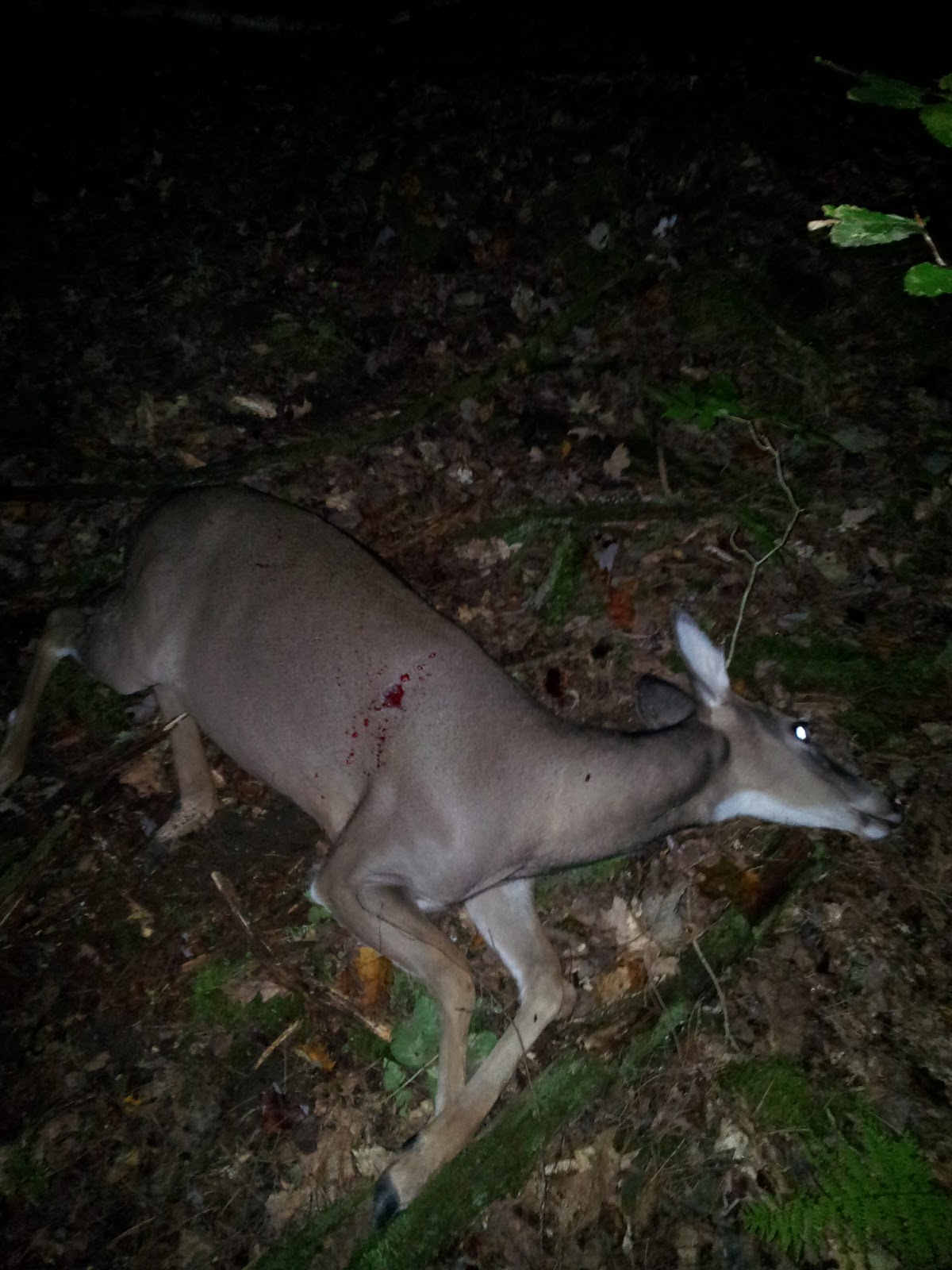This pass-through led to an interesting conversation with Sheikh Abdul-Karim Yahya. Over dinner he mentioned the hadith where the Prophet (Allah bless him and give him peace) said: “Some people will emerge from [the east] who will recite the Qur’an, but it will not go beyond their throats. They will pass through Islam as the arrow passes through game.” Sh. Abdul-Karim said he did not fully understand the meaning of the phrase “as the arrow passes through game” until he saw these photos.
The most ethical shot when hunting big game is placed directly behind the shoulder blade. The majority of the animal’s vital organs are clustered in this area. Thus, a well-placed shot causes hemorrhaging, and the animal dies due to a lack of oxygen to the brain.

The deer in this photo presented a perfect broadside shot at 22 yards. My arrow found its mark, and after the shot, the deer ran about 40 yards and expired. I thank my Lord for the bounty of wholesome food that is pure, and nothing less than a gift from His benevolence.
After the shot, I gathered my equipment and descended from my tree perch. I followed the blood-trail to the deer and “tagged” it. Tagging requires that a hunter fill out all appropriate information on his or her state-issued hunting license. This process allows the state to track the number of deer killed during a season and provides other important statistical information, such as the size of the herd, which helps regulate the deer population.
The next step is to field dress the deer, that is, removing the animal’s entrails. Field dressing is always a sobering experience. The animal’s body is still warm—depending on how quickly you recover it—and the warmth inside the animal is a stark reminder of the proximity between life and death.
When field dressing a deer, I make sure the entrails are taken far away from any place where people or dogs may encounter this “gut pile.” By leaving the “gut pile” uncovered and not burying it, I am intentionally allowing it to return to the earth. The entrails will be eaten by carnivora, rondentia, corvidae, insects, and so on, and after a short period it will all return back to the soil in one form or another. This is what the author Tovar Cerulli describes in his book The Mindful Carnivore as a “cyclical system,” nothing is wasted!

I remove the skin of the deer before beginning the quartering process. Quartering refers to the removal of the deer’s limbs by cutting off the two hindquarters and the two front quarters. During this time I also remove the backstraps and tenderloins, arguably these are the best cuts from a deer. Speaking from experience, I fully agree with that claim!

This is my current set up for processing the deer. Not ideal! However, it gets the job done. I plan on investing in a larger cutting board and better knives for next season. On the right is the hind-quarter. A butcher once taught me how to make a “butterfly cut,” which starts at the top joint of the ball and socket. By keeping the knife pressed tight against the bone and working it down the full length of the bone, I am able to open up this large group of muscles. Once the hind-quarter is opened, I remove top and bottom round (cuts), a rump roast and other steaks that I use for kababs. The bones are used for stews, and then boiled down for stock.
The cuts normally look something like this.

In the photo on the right, the top left tray is meat from the hind-quarters—steaks, stews and kebabs. In the top right tray are bones that we use for stews and stocks, and we also use the entire neck for stew as well. The bottom tray (left corner) is meat that we grind into ground venison. We normally use this for burgers and spaghetti sauces. Two of my children have a wheat allergy, and we use spaghetti squash as a replacement for pastas. The piece of meat in the middle is a roast, and it’s pretty self-explanatory what we do with that. The meat on the right is backstrap and tenderloin. We normally broil these cuts in an oven or grill them after marinating them for a full day or longer. My wife found this venison tenderloin marinade that works great with either of these cuts. This recipe will blow you away!
I like the backstrap and tenderloin because they cook fast and travel well. I have even taken them cuts into the field with me and cooked them on my Pocket Rocket Backpack Stove.
Industrial meat production is a business shrouded in mystery. The consumer is locked out, and is rarely offered the opportunity to actually witness how animals live, how they are slaughtered, and how they are processed. I find solace in knowing exactly where my meat comes from, where it lived, what it ate, and how it died. Hunting is my objection to factory farming; it is my personal response to this oppressive practice. All of us have choices and we should try our best to exercise these choices in a way that creates a paradigm shift in thought and practice.
As Muslims, our nourishment is directly related to our spiritual states—we are concerned with what goes in our mouths and what comes out of them. I hope this helps readers understand what hunting can look like, and I hope this motivates us to search for what is Beyond Halal!